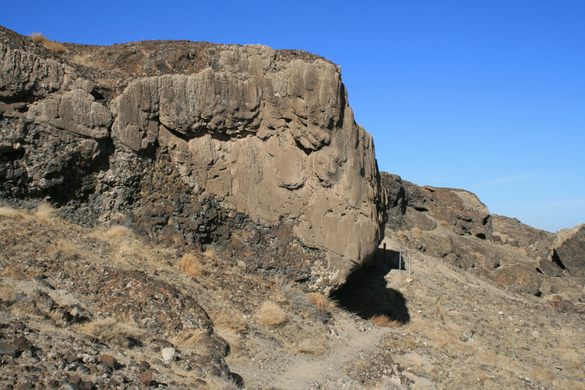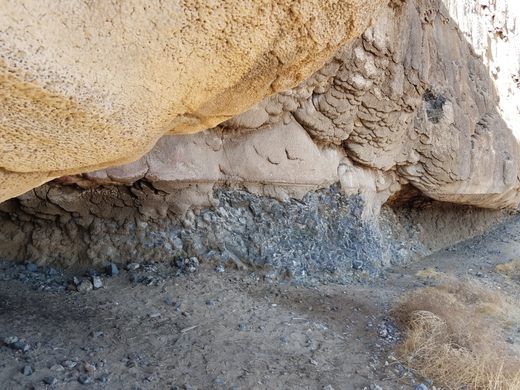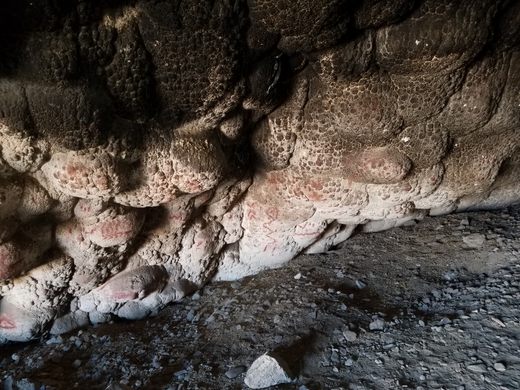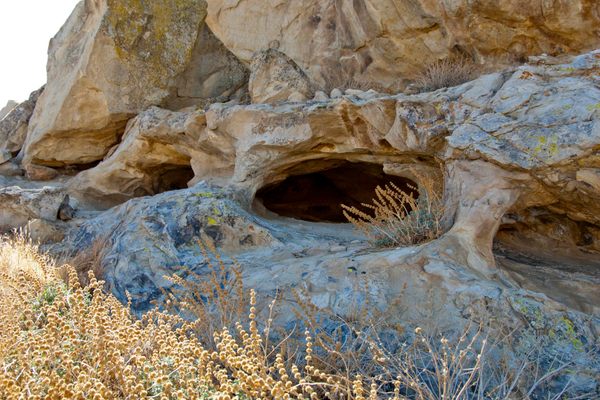Salt Cave
Red ocher pictographs survive in this tufa rock shelter on the shore of an ancient lake.
Pleistocene Lake Lahontan covered much of western Nevada, with a peak level around 15,000 years ago. As the lake level dropped over the ensuing millennia, wave action along the shore caused substantial erosion, as the lake was still large enough to generate surf.
In some cases, the wave action carved out overhangs along the shore, as the surf dug into the material at the shoreline. In addition, due to the chemistry of Lake Lahontan, tufa, a freshwater limestone, was deposited abundantly around the lake, and tufa deposits encrusted the shoreline and were undercut and worn away by the surf.
Early Indigenous inhabitants occupied these wave-cut shelters several thousand years ago when the lake still provided resources before it vanished. Salt Cave is one such shelter, consisting of an arch-like tufa-encrusted alcove. The Hidden Cave at Grimes Point, directly east across the basin from Salt Cave, is another example.
The tufa on the roof of Salt Cave is deeply soot-stained toward the back, both from the fires of early inhabitants and from those of later campers. Toward the entrance of the cave, where the tufa is whitish and largely free of soot, is an abundance of red ocher pictographs. Some are simply spots, while others are obvious hand prints, aligned dots, rosette-like features, wavy lines that may represent snakes or water, and even more enigmatic designs.
The white tufa may have been preferred as a substrate simply because the pictographs show up better, although some farther back may have later been covered by soot. Those nearest the entrance are faded and fragmentary due to weathering. The meaning of the pictographs is uncertain.
Know Before You Go
The easiest approach, from the east off farm roads around Fallon, is often not available because it crosses part of the Fallon Naval Air Station and may be closed for training exercises.
This road, Sand Canyon Road, starts from the corner (which is at about 39.40192 N, 118.83801 W) of Solias Road and Lone Tree Road, at the edge of the farmlands. From this corner Sand Canyon Road first heads south and then bends southwesterly.
After five miles go south (left) at an intersection at about 36.36631 N, 118.91219 W, and proceed for one mile to an intersection at around 39.35344 N, 118.90685 W. From here go west (right) 1.4 miles to pick up a dirt road along the low hills ahead. At the intersection with this road (at about 39.34436 N, 118.93024 W), go south about 0.4 miles. The cave is in the hills on the right (west). There is a small informal parking area off the road to the east. The cave is at about 39.33929 N, 118.93087 W.
These roads should be passable to passenger cars in dry weather, but high clearance will probably be appreciated.
If the Sand Canyon Road is not available, you can come in from the west, but it will involve about 20 miles on dirt roads on which high clearance will be necessary and 4WD.
In winter, when the old lakebed deposits are wet, the route may be impassible even to 4WD vehicles because of deep mud.
On Alternate US-95 about 0.8 miles south of Buckland Station, at the bridge over the Carson River, turn left (east) on the Simpson Road/Old Pony Express route, this junction being at about 39.28440 N, 119.24277 W. Proceed 10.7 miles, going generally eastward, to a junction at 39.27575 N, 119.04994 W and head north here.
(The site of the Hooten Wells Pony Express station is about 1/4 mile east of this junction and is marked with some ruins and an interpretive sign. It makes a worthwhile side trip on the way.)
The main road will bend generally northeasterly and finally east, winding around the low rocky hills to the south where the cave is located. Several side roads branch off, but at all junctions keep heading generally eastward.
After 9.2 miles take a shallow junction to the right (at 39.34409 N, 118.93197 W) and follow it for 0.1 mile, where you will join the road to the cave (this latter junction is at about 39.34354 N, 118.92979 W). Head south from this point as above.
Pictographs are irreplaceable. Please don't touch them; photograph them only.





































Follow us on Twitter to get the latest on the world's hidden wonders.
Like us on Facebook to get the latest on the world's hidden wonders.
Follow us on Twitter Like us on Facebook